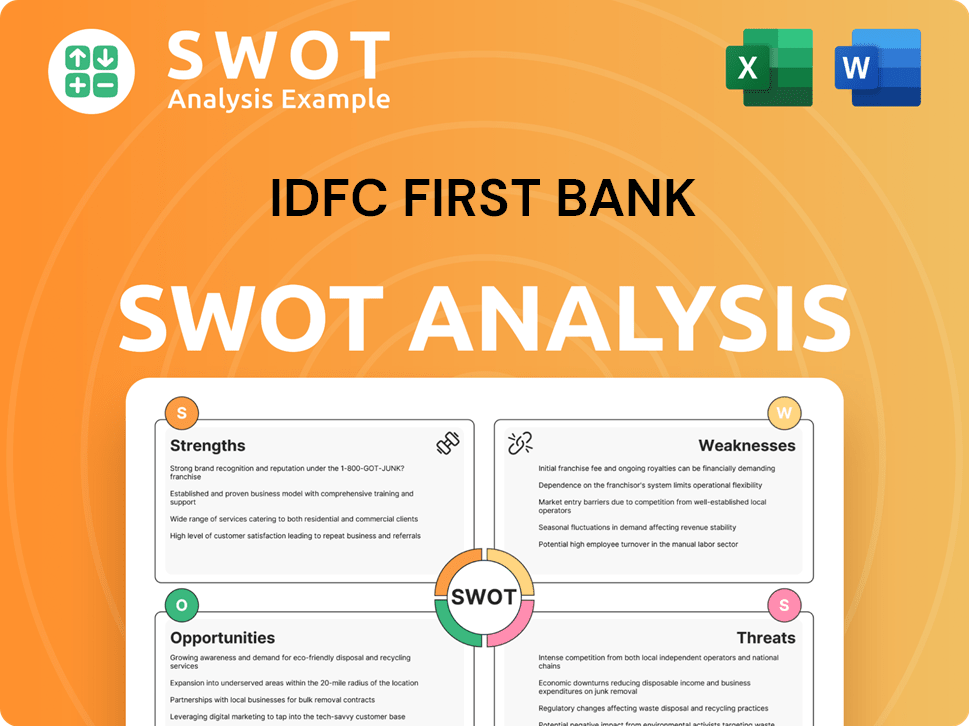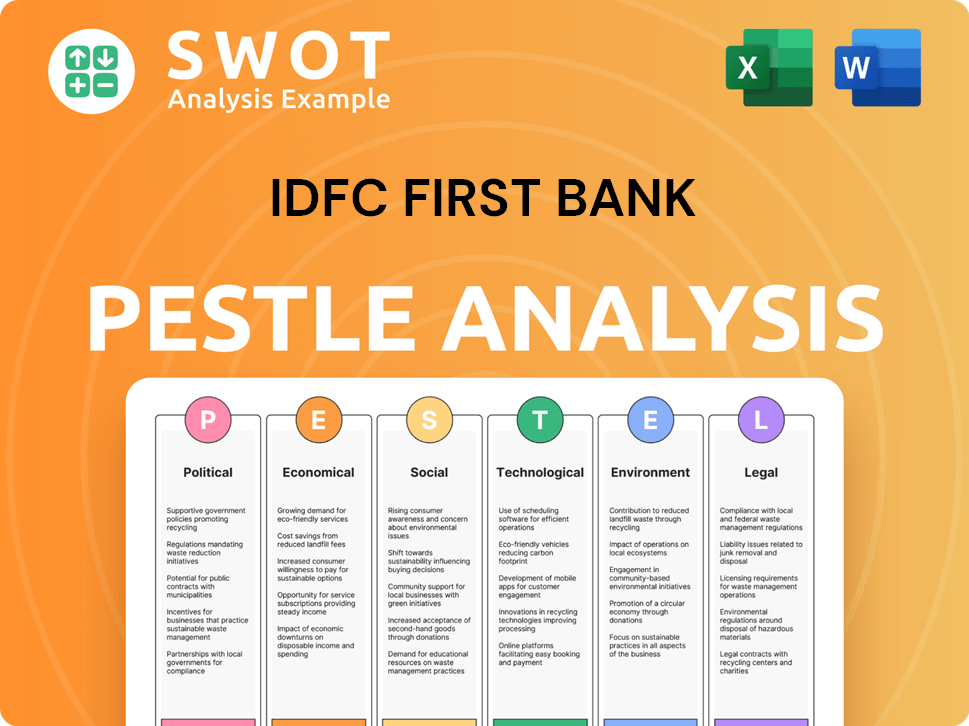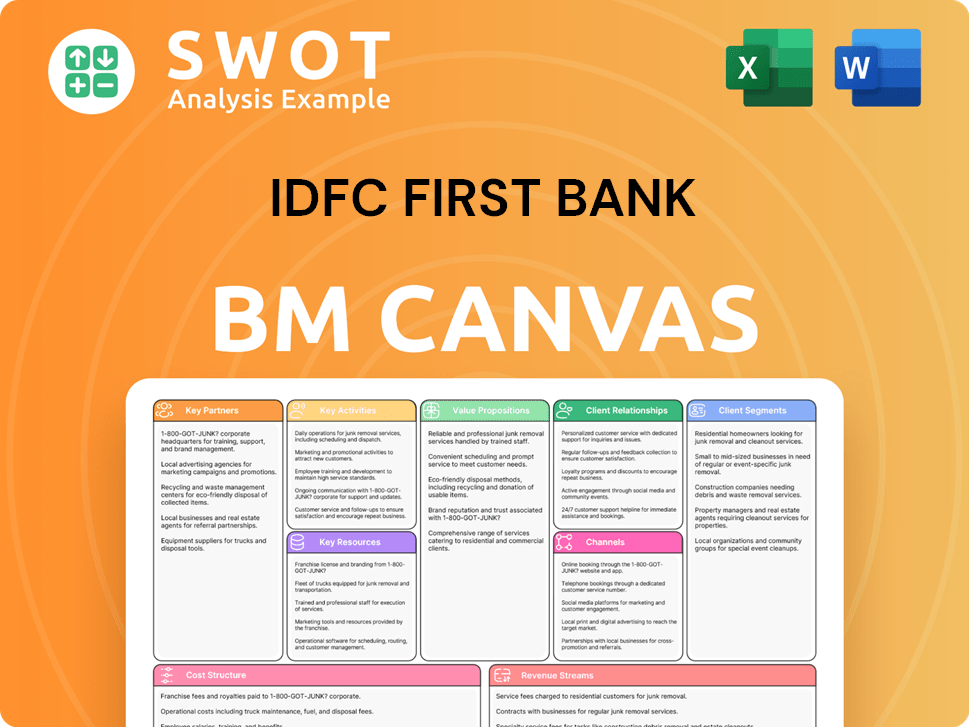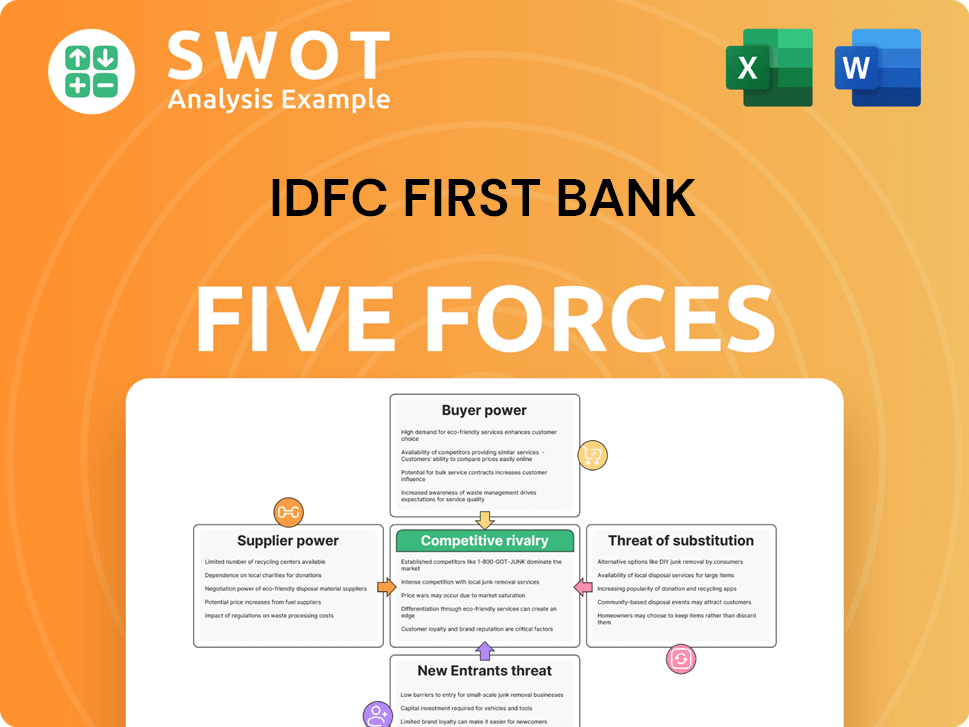IDFC First Bank Bundle
How did IDFC First Bank rise to prominence in India's financial sector?
Embark on a journey through the IDFC First Bank SWOT Analysis to uncover the fascinating story of IDFC First Bank, a leading private sector bank in India. From its roots in infrastructure financing to its current status as a universal bank, its evolution is a testament to strategic adaptation and market understanding. Discover the key milestones and pivotal decisions that shaped the IDFC Bank history.

The IDFC First Bank company's transformation began with the 2018 merger of IDFC Bank and Capital First, a move that redefined its strategic focus. This IDFC merger allowed the bank to combine its expertise in infrastructure with retail lending, expanding its customer base and service offerings. Understanding IDFC First Bank's timeline and the IDFC Bank founder's vision is crucial to grasping its impact on the Indian banking sector and its future trajectory.
What is the IDFC First Bank Founding Story?
The story of IDFC First Bank begins on October 1, 2015, as IDFC Bank, a subsidiary of IDFC Limited. This marked the start of a new chapter for a financial institution with roots stretching back to 1997.
The foundation of IDFC First Bank was laid by Infrastructure Development Finance Company (IDFC), established by the Government of India to fund infrastructure projects. The bank's evolution involved strategic decisions and key leadership, including the merger with Capital First Limited in 2018.
This transformation aimed to create a comprehensive financial services provider, blending corporate banking with retail lending expertise. The bank's journey reflects its commitment to innovation and customer-centric approaches in the Indian banking sector.
IDFC First Bank was established on October 1, 2015, as IDFC Bank, a banking subsidiary of IDFC Limited, which was founded in 1997 by the Government of India.
- Dr. Rajiv Lall joined IDFC in 2005, expanding into asset management.
- In 2013, a commercial banking license was applied for, granted in April 2014.
- IDFC Limited divested its infrastructure finance assets to form IDFC Bank, which began operations on October 1, 2015.
- The bank was inaugurated by Prime Minister Narendra Modi.
A significant milestone in the IDFC Bank history was the merger with Capital First Limited in December 2018, finalized in April 2019. This strategic move combined IDFC Bank's corporate banking experience with Capital First's retail lending expertise.
Capital First, founded in 2012 by V. Vaidyanathan, brought innovative products and a customer-focused approach to the merger. The merger aimed to address challenges with bad loans and diversify the loan book, creating a comprehensive financial services provider. The combined entity was renamed IDFC First Bank. Learn more about the bank's financial strategies by reading about the Revenue Streams & Business Model of IDFC First Bank.
In the fiscal year 2024, IDFC First Bank reported a net profit of approximately ₹2,988 crore, a significant increase from the previous year. The bank's total advances grew to around ₹1.63 lakh crore, reflecting its expansion strategy. Furthermore, the bank's focus on digital initiatives and customer service has driven its growth in the Indian banking sector.
IDFC First Bank SWOT Analysis
- Complete SWOT Breakdown
- Fully Customizable
- Editable in Excel & Word
- Professional Formatting
- Investor-Ready Format

What Drove the Early Growth of IDFC First Bank?
The early growth and expansion of IDFC First Bank began with its launch in October 2015, initially focusing on commercial and wholesale banking. The bank aimed to provide services, particularly in rural India, with an emphasis on digital banking. A pivotal moment in its history was the merger with Capital First Limited, which was completed in April 2019, fundamentally reshaping its trajectory.
The merger with Capital First in December 2018, finalized in April 2019, was a key strategic move. This acquisition allowed IDFC First Bank to significantly expand its retail loan portfolio. The integration of Capital First was crucial for the bank's shift towards a retail-focused business model.
By December 2024, the retail loan book had grown to approximately ₹187,000 crore. This growth reflects the bank's strategic shift towards retail lending. The increasing proportion of granular retail and commercial book accounted for 83% of the overall funded assets as of June 30, 2024.
Customer deposits experienced robust growth, increasing by 25.2% year-on-year from ₹1,93,753 crore as of March 31, 2024, to ₹2,42,543 crore as of March 31, 2025. Retail deposits specifically grew by 26.4% year-on-year to ₹1,91,268 crore by March 31, 2025, constituting 79% of total customer deposits.
The CASA (Current Account Savings Account) ratio improved significantly from 8.7% in FY19 to 46.9% as of March 31, 2025. The bank's total funded asset book grew by 20.4% to ₹2,41,926 crore by March 31, 2025. Despite a slowdown in retail loan growth across major banks in Q4 FY25, IDFC First Bank's retail finance credit grew by 18.7%.
IDFC First Bank PESTLE Analysis
- Covers All 6 PESTLE Categories
- No Research Needed – Save Hours of Work
- Built by Experts, Trusted by Consultants
- Instant Download, Ready to Use
- 100% Editable, Fully Customizable

What are the key Milestones in IDFC First Bank history?
The history of IDFC First Bank is marked by significant achievements and strategic shifts. The bank has consistently expanded its services and reach, adapting to the evolving financial landscape in India. This journey includes key mergers, innovative digital initiatives, and recognition in the banking sector, making it a notable player in the Indian financial market. Learn more about the Owners & Shareholders of IDFC First Bank.
| Year | Milestone |
|---|---|
| 2018 | IDFC Bank merged with Capital First, creating IDFC First Bank. |
| 2024 | The bank's mobile app was ranked 4th globally by Forrester in its Q4 report on Global Mobile Banking Apps. |
| 2025 | IDFC First Bank was recognized among the 'World's Best Banks 2025' by Forbes. |
| 2025 | Won the 'Best Private Sector Bank Award' and 'India's Leading Private Bank (Mid)' at Dun & Bradstreet's BFSI & Fintech Summit 2025. |
IDFC First Bank has focused on digital transformation, offering 100% digital core banking solutions and a user-friendly mobile app. The bank introduced India's first AI-powered interactive avatar of its brand ambassador to enhance customer engagement.
IDFC First Bank provides 100% digital core banking solutions.
The bank's mobile app was ranked 4th globally by Forrester in its Q4 2024 report on Global Mobile Banking Apps.
Introduced India's first AI-powered interactive avatar of its brand ambassador to enhance customer engagement.
Despite its achievements, IDFC First Bank has faced challenges, including a decline in its microfinance loan portfolio. The net profit for Q4 FY25 fell by 58% year-on-year to ₹304 crore due to elevated provisions and asset quality challenges in the microfinance sector.
The microfinance loan book decreased by 28.3% year-on-year and now constitutes only 4% of the total loan book as of March 31, 2025.
Net profit for Q4 FY25 fell by 58% year-on-year to ₹304 crore.
Gross NPA improved to 1.87% and Net NPA at 0.53% as of March 31, 2025.
IDFC First Bank Business Model Canvas
- Complete 9-Block Business Model Canvas
- Effortlessly Communicate Your Business Strategy
- Investor-Ready BMC Format
- 100% Editable and Customizable
- Clear and Structured Layout

What is the Timeline of Key Events for IDFC First Bank?
The IDFC First Bank company has a rich history, evolving significantly since its inception. Starting as IDFC Limited in 1997, it transitioned into a bank, marked by mergers and acquisitions. Key milestones include the RBI's approval in 2014, the commencement of operations in 2015, and the merger with Capital First in 2018-2019, which formed the current entity. The bank has consistently focused on growth, customer deposits, and digital innovation, as seen in its recent financial results and initiatives.
| Year | Key Event |
|---|---|
| 1997 | IDFC Limited was established to finance infrastructure projects. |
| 2014 (April 9) | The Reserve Bank of India granted in-principle approval for IDFC Limited to set up a new bank. |
| 2015 (October 1) | IDFC Bank began operations after demerging from IDFC Limited. |
| 2016 | IDFC Bank acquired Grama Vidiyal Micro Finance Limited. |
| 2018 (December) | IDFC Bank merged with Capital First Limited. |
| 2019 (April) | The merger of IDFC Bank and Capital First was completed, forming IDFC First Bank. |
| 2024 (March 31) | Total customer deposits reached ₹1,93,753 crore, with a CASA ratio of 47.2%. |
| 2024 (October 2) | Forrester study rated IDFC First Bank as the top-rated banking platform for Indian customers. |
| 2024 (December 6) | IDFC First Bank unveiled India's first AI-powered interactive avatar of Amitabh Bachchan. |
| 2025 (January 3) | Total business expanded by 25.2% year-on-year to ₹4,58,213 crore. |
| 2025 (March 31) | Customer deposits increased to ₹2,42,543 crore, with retail deposits growing by 26.4% year-on-year. Gross NPA improved to 1.87% and Net NPA marginally increases to 0.53%. |
| 2025 (April 17) | The Board approved a preferential issue of equity capital amounting to approximately ₹7,500 crore to Warburg Pincus and ADIA affiliates, subject to approvals. |
| 2025 (April 26) | Reported Q4 FY25 net profit of ₹304 crore, a 58% year-on-year decrease, largely due to microfinance portfolio challenges. |
| 2025 (May 20) | Shareholders approved fund infusion by Warburg and ADIA but rejected a proposal allowing Currant Sea Investments to nominate a non-executive director to the bank's board. |
IDFC First Bank aims for continued growth, focusing on strengthening its balance sheet through strategic capital raises. The recent capital infusion of approximately ₹7,500 crore from Warburg Pincus and ADIA affiliates is a pivotal step. This infusion is set to boost the overall capital adequacy from 16.1% to 18.9%.
The bank's financial performance shows a mixed trend, with significant growth in customer deposits and total business. However, the Q4 FY25 net profit decreased by 58% year-on-year, mainly due to challenges in the microfinance portfolio. The bank's ability to manage and mitigate these issues will be crucial.
IDFC First Bank is investing in digital initiatives, as demonstrated by the launch of India's first AI-powered interactive avatar. These initiatives are aimed at enhancing customer experience and driving operational efficiency. The bank's focus on digital innovation is expected to play a key role in its future success.
The bank's strong market position is reflected in the Forrester study, which rated it as the top-rated banking platform for Indian customers. This recognition underscores the bank's commitment to customer satisfaction and its ability to compete effectively in the market. The bank's strategic moves will be crucial for maintaining and improving its market position.
IDFC First Bank Porter's Five Forces Analysis
- Covers All 5 Competitive Forces in Detail
- Structured for Consultants, Students, and Founders
- 100% Editable in Microsoft Word & Excel
- Instant Digital Download – Use Immediately
- Compatible with Mac & PC – Fully Unlocked

Related Blogs
- What is Competitive Landscape of IDFC First Bank Company?
- What is Growth Strategy and Future Prospects of IDFC First Bank Company?
- How Does IDFC First Bank Company Work?
- What is Sales and Marketing Strategy of IDFC First Bank Company?
- What is Brief History of IDFC First Bank Company?
- Who Owns IDFC First Bank Company?
- What is Customer Demographics and Target Market of IDFC First Bank Company?
Disclaimer
All information, articles, and product details provided on this website are for general informational and educational purposes only. We do not claim any ownership over, nor do we intend to infringe upon, any trademarks, copyrights, logos, brand names, or other intellectual property mentioned or depicted on this site. Such intellectual property remains the property of its respective owners, and any references here are made solely for identification or informational purposes, without implying any affiliation, endorsement, or partnership.
We make no representations or warranties, express or implied, regarding the accuracy, completeness, or suitability of any content or products presented. Nothing on this website should be construed as legal, tax, investment, financial, medical, or other professional advice. In addition, no part of this site—including articles or product references—constitutes a solicitation, recommendation, endorsement, advertisement, or offer to buy or sell any securities, franchises, or other financial instruments, particularly in jurisdictions where such activity would be unlawful.
All content is of a general nature and may not address the specific circumstances of any individual or entity. It is not a substitute for professional advice or services. Any actions you take based on the information provided here are strictly at your own risk. You accept full responsibility for any decisions or outcomes arising from your use of this website and agree to release us from any liability in connection with your use of, or reliance upon, the content or products found herein.